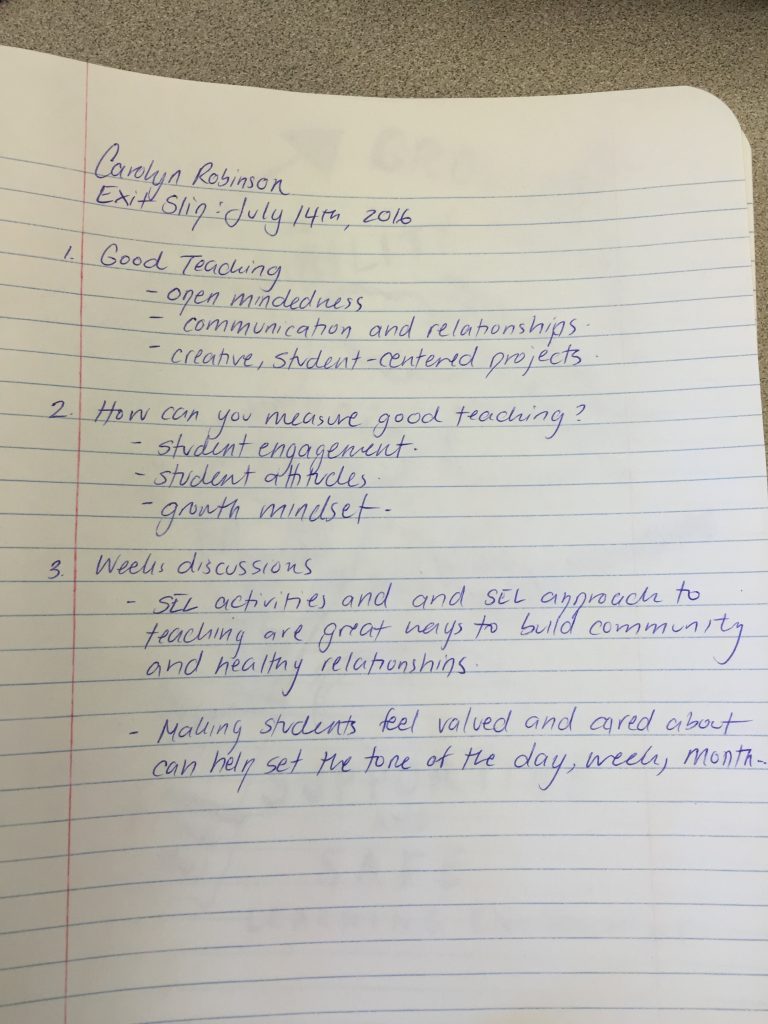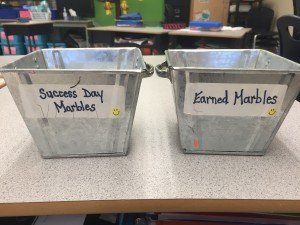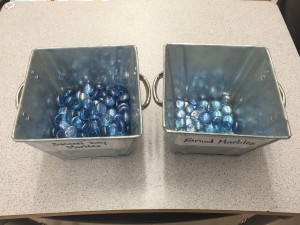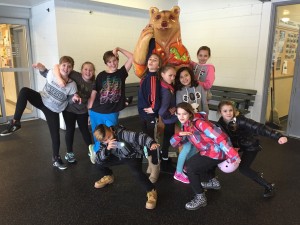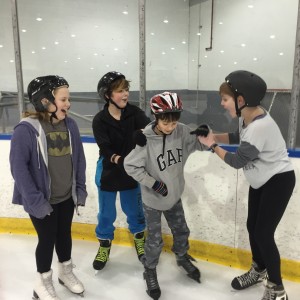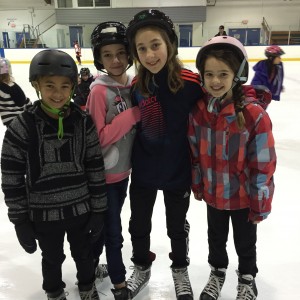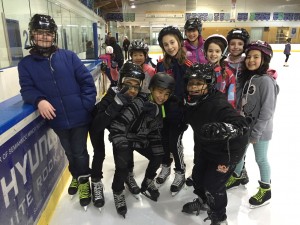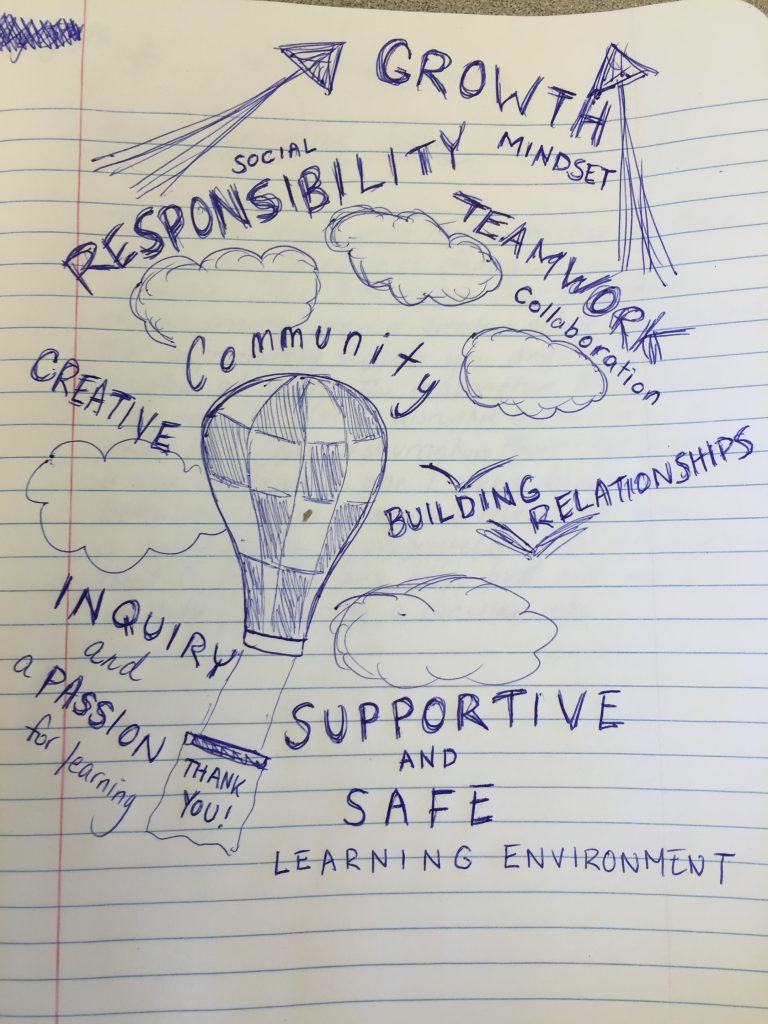
Inquiry Class Exit Slip: July 14th, 2016
Annotated Bibliography
Over the past several months the following articles, studies, and websites have not only changed the way I think about disruptive behaviour within the classroom, but they have also influenced my developing teaching philosophy and inspired me to become a better educator of children.
Wells, Karin. (2013) Self-regulation technique helps students focus in class: CBC News Canada. Retrieved From: http://www.cbc.ca/news/canada/self-regulation-technique-helps-students-focus-in-class-1.2440688
This article discusses the work of researcher Staurt Shanker in regards to minimizing disruptive behaviour within the elementary school classroom. Shanker’s research suggests that the best way for a teacher to manage events of disruptive behaviour is to ‘de-escalate’ the situation, or in other words, to teach the child how to calm themselves down and get them to think again. Studies show that when a child’s brain enters a state of stress, anxiety, or general overload of some sort, that the child’s ‘thinking’ part of the brain shuts off and they can no longer hear what anyone is saying to them, which is why self-regulation and teaching our students how to self-regulate themselves is so important. Within the article, author Karin Wells provides several examples that teachers can use to help teach and implement self-regulation within the classroom. Personally, I found many of the ideas outlined in this article to be very useful for minimizing instances of disruptive behaviour within the classroom. Although I think that student self-regulation can be a useful tool for many teachers and students, I was able to learn through my inquiry research that it is only one small piece of a much larger puzzle.
Jacobsen, Kari. (2013). Educators’ Experiences with Disruptive Behavior in the Classroom: Master of Social Work Clinical Research Papers.
This research article discusses how instances of disruptive behaviour in a classroom setting have been proven to negatively impact both the individual distributing the behaviour as well as other students. Additionally, findings have also shown that disruptive behaviour can impair the classroom learning environment. Within the article, author Jacobsen pays particular attention to how disruptive behaviour is a common predictor for low grades and higher school drop-out rates. Finally, the importance for educators to both educate themselves and understand the source of a child’s disruptive behaviour are also discussed. For many children their teacher is the adult they see most often throughout the day, and thus, how a teacher decides to respond to instances of disruptive behaviour is extremely important. Especially relevant to my inquiry research topic is the discussion around teacher detection and intervention in disruptive behaviours and/or in developing mental health disorders.
Rosenberg, M., Michael S Rosenberg, & Lori A Jackman. (2003). Intervention in school and clinic: Development, implementation, and sustainability of comprehensive school-wide behavior management systems Pro-Ed, 39(1), 10-21.
This research paper discusses a variety of research findings which show that behaviour management and instances of disruptive behaviour in the classroom are the most troubling issues facing schools and teachers today. Throughout the article authors Rosenberg and Jackman describe a behaviour management system in which collaborative teams work together to form consensus on a positive and supportive school-wide approach to behaviour management for all children and how this model could be used to help minimize instances of disruptive behaviour within the classroom. Although I found some of the ideas in this article to be thought-provoking, I was more interested in directing my inquiry research project in a slightly different direction. That being said, this source was definitely relevant in my field of study and it did provide me with a more thorough understanding of how complex effective behaviour management can be.
Clayton State University Education Department Website (2016). Disruptive Classroom Behaviour. Retrieved from:http://www.clayton.edu/Portals/5 DisruptiveClassroomBehavior.pdf
This University document provides a broader, more inclusive definition of what disruptive behaviour can look like and what disruptive behaviour actually is. Within this document disruptive behaviour is defied as any behaviour that hampers the ability of instructors to teach and students to learn. Alongside this definition, a list of common examples of disruptive behaviour within the classroom is also provided. Personally I found this resource to be very useful in the early stages of my research on disruptive behaviour. This resource allowed me to develop a better understanding of some of the different types of disruptive behaviour that can occur within a classroom setting as well as how and why certain types of disruptive behaviour develop in children.
Lambert, M. C., Cartledge, G., Heward, W. L., Lo, Y., & Koegel, R. L. (2006). Effects of response cards on disruptive behavior and academic responding during math lessons by fourth-grade urban students. Journal Of Positive Behavior Interventions, 8(2), 88-99.
Although I have had serval past experiences using student response cards within an elementary school classroom, I was completely unaware of the benefits associated with them before reading this article. Within the article authors describe and explain the results of an experiment in which two separate 4th-grade urban education classrooms incorporated the use of student response cards into the daily math lessons. Findings show that by incorporating the response cards into the classroom, student engagement went up, disruptive behaviour went down, and student responding increased significantly. Many of the ideas described within this article, in addition to researched findings, definitely helped to reframe my own beliefs about the way I think about disruptive behaviour within the classroom. Specifically, I would say that the ideas outlined within this particular article helped guide and direct me through the majority of my inquiry research.
Moore Partin, T. C., Robertson, R. E., Maggin, D. M., Oliver, R. M., & Wehby, J. H. (2010). Using Teacher Praise and Opportunities to Respond to Promote Appropriate Student Behavior. Preventing School Failure, 54(3), 172
This article discusses several important strategies for decreasing disruptive behaviour within the classroom. The two major strategies discussed within the article are: teacher praise as a positive reinforcement and providing students with more opportunities to respond correctly to academic questions, tasks, and demands. The authors note that using these strategies appears to help all students, but especially those students with learning disabilities or disruptive tendencies. Especially relevant to my inquiry topic is the discussion of using teacher-centred strategies to improve student behaviour within the classroom.
Scripp, L. (2002). An overview of research on music and learning. Critical links: Learning in the arts and student academic and social development. (Ed. R.J. Deasy), 132-136. Washington, DC. Arts Education Partnership.
This essay discusses and reviews a variety of research which shows how music can be used as a tool for social-emotional development and behaviour modification in schools. Based on the research examined within this essay the author argues that music should be incorporated in education for the many positive impacts that it can have both in the classroom and for students. Some of the positive impacts identified in this paper include: improved student academic success and performance, improved student motivation, improved student behaviour, and finally, the overwhelmingly positive impact it can have on a child’s social emotional development and their overall ability to learn. Many of the ideas outlined in this essay provide new insight into how teachers can use music as a tool to help minimize instances of disruptive behaviour within the classroom. Incorporating music into the classroom is something that I have already tried several times with my practicum class, and I would definitely agree that music has the capability to improve student behaviour.
Gouzouasis, P., Guhn, M., & Kishor, N. (2007). The predictive relationship between achievement in music and achievement in core grade twelve academic subjects. Music Education Research, 9(1), 81-92.
This article discusses the results of a longitudinal study which examines the relationship between student involvement in music and the corresponding academic success. After the thorough examination of three different groups of students, all of the collected results of this study reveal that – yes – there is a positive correlation between involvement in music and achievement in achievement in core academic subjects. Specifically it was found that students who had participated in band, choir, or music composition, on average, had higher achievement in mathematics, biology, and English. In addition to these findings, there is evidence that student involvement in musical activities increases self-esteem and social competences, including the reduction in aggressive and anti-social behaviour as well as the increase in pro-social behaviour. Many of the ideas described in this article have helped to shape the way I think about managing disruptive behaviours within the classroom.
Hamre, B. K., & Pianta, R. C. (2006). Student-teacher relationships. In G.G. Bear & K. Minke (Eds.), Children’s Needs III: Development, prevention, and intervention (pp. 59-71). Bethesda, MD: NASP.
This article discusses the importance of student-teacher relationships as an indicator for student success and behaviour. Within the article it is noted that positive student-teacher relationships are extremely important to establish within the classroom as they are often huge predictors of student social emotional development and student academic success. In building upon this idea, the article also discusses recent research which shows that positive student-teacher relationships can help minimize disruptive behaviour within the classroom, help reduce the amount of time spent on behaviour management, and make learning more meaningful. I am extremely grateful that my inquiry research lead me to explore student-teacher relationships because I am only just beginning to understand how important relationships are for student well-being, academic success, and social-emotional development.
Linsin, M. (2009). How to build classroom community: It’s not what you think. SCM, Online.
This article discusses how the process of building a strong classroom community can help improve both student motivation and student behaviour. Within the article the author notes that when students act in a kind and appropriate way it is not because there is a strong classroom community, but rather, it is the result of a strong classroom community. Specifically it is stated that in order for students to properly build a strong classroom community their teacher must first create an enticing goal, then make sure that every class member is needed to achieve the goal, and finally, make sure that there is a chance of failure. This article outlines that if the above three conditions are implemented correctly by the teacher, the close bonds that students will develop through these repeated experiences will carry over to everything they do in the classroom, including how they choose to behave. This resource helped me understand relationships and community within the classroom from a slightly different perspective, a perspective in which the teacher provides the right conditions for building a strong classroom community, but where the students are responsible for building camaraderie, teamwork, and togetherness.
Improving Behaviour: To Act Without Prompting
Over the past several weeks the majority of my research has focussed on how good teaching practices can help minimize instances of disruptive behaviour within the classroom. Although I feel as if my inquiry has opened my eyes to so many ways that I can be a better teacher for all of my students, I still found myself being curious about one thing — student internal motivation. How can I get my students to want to choose to behave appropriately in the classroom and in social situations without teacher encouragement, reminders, and presence? In other words, how can I get my students to act without prompting?
Upon reading through a variety of articles on internal motivation I stumbled across one article that I found to be particularity enlightening. In the article “How To Build Classroom Community: It’s Not What You Think” author Michael Linsin discusses how the process of building a strong classroom community can help improve both student motivation and student behaviour. Within the article former fourth-grade teacher Michael Linsin notes that, “…the whole idea of having a strong [classroom] community is that we want our students to act without prompting. We want teamwork and camaraderie to be who they are and how they choose behave, not something foisted upon them by the teacher” (2009, p.1). Linsin asserts that when students act in a kind and appropriate way it is not because there is a strong classroom community, but rather, it is the result of a strong classroom community (2009). Specifically, it is stated that in order for students to properly build a strong classroom community their teacher must first create an enticing goal, then make sure that every class member is needed to achieve the goal, and finally, make sure that there is a chance of failure (Linsin, 2009). Overall, the article outlines that if the above three conditions are implemented correctly by the teacher, the close bonds that students will develop through these repeated experiences will carry over to everything they do in the classroom, including how they choose to behave (Linsin, 2009).
At this point in my inquiry research, this idea speaks volumes to me. Personally I love how this article approaches the topic of disruptive behaviour from a slightly different perspective, a perspective in which the teacher provides the right conditions for building a strong classroom community, but where the students are responsible for building the camaraderie, teamwork, and togetherness that is necessary for success. Furthermore, I find this perspective to be refreshing but also promising.
This idea of building community through a collective goal to improve student behaviour is something that I have been lucky enough to experience first-hand this past year. In my practicum class there are 2 buckets of marbles known as the ‘success day marbles’. In one bucket there are 100 marbles, each one with the potential to be earned by the class when they demonstrate collective teamwork. The second bucket is where each earned marble is placed when they entire class successfully accomplishes a goal together. Once all 100 marbles have transferred from the first bucket to the second it signifies that students within the class have successfully worked together to earn an entire day celebrating their teamwork. On this day of celebration, the classroom will be transformed into a giant blanket-fort and there will be freshly popped popcorn, hot chocolate, candy, and projected movies within the classroom-made fort. This day will be a time for the class to celebrate their collective achievements, celebrate camaraderie, and develop relationships.
As an observer in my practicum class I always thought that the ‘success day marble buckets’ were a great idea to help motivate students, but now I understand that they are so much more then that. In only a few short weeks I will begin my extended practicum, and in a sense, I will be put to the test. Although I am unable to say what challenges and successes I will encounter over these next several months, I can confidently say that I am so thankful for the tools and ideas I have acquired though researching my inquiry topic of disruptive behaviour.
Linsin, M. (2009). How to build classroom community: It’s not what you think. SCM, Online.
Sunnyside Reflection: March 3, 2016
The Drumming Lesson
Today at Sunnyside I took on my riskiest lesson yet — drumming. Going into this lesson I was slightly nervous because not only was it going to be a first experience for many of the students within the class, but it was also going to be my first experience taking on a music lesson.
In addition to the nerves I had going into this lesson, the preparation required for this lesson was also complicated and I knew that my timing and execution had to be flawless for everything to go smoothly. Since the music room is booked all day during our Thursday visits to Sunnyside, I arranged for our drumming lesson to take place in the portable outside of the school, in the hopes that we would not disrupt any other classes with the loud drumming. Since the lesson was planned for outside in the portable, this meant moving 30 large drums outside during lunch hour. Time and time again I am so impressed with how many students jump at the opportunity to help set up lessons, so luckily I had a lot of help accomplishing this daunting task.
Once the students were back inside after lunch the transition outside to the portable with the class was smooth and efficient. The kids were all beyond excited to start playing the drums. After we had settled into the portable, I re-stated my expectations and rules for the lesson, as I knew it had the potential to get out of hand considering the type of lesson it was. I first outlined my expectations for the lesson back inside the school before we left for the portable, so the students were all very aware of the ‘stop-drumming’ signal before we even left for the lesson.
After entering the portable I asked the students to take a seat in an empty desk and we played a rhythm game without the drums. This game went even better then I expected it to. This kids had a blast and wanted to play it over and over again, so we did. As we practiced the rhythms together as a class, we started performing the pattern faster and faster until the room erupted in laughter. This was a great moment. Next it was time to bring out the drums. As a class, we moved all of the desks out of the way, created a large circle in the middle of the room with the chairs, and I proceeded to hand out the drums. Before I handed out any drum sticks to students I talked about how it is important to respect the instruments, and I once again reminded them about the signal I would give them when I wanted them to stop drumming. This signal was 2 hands up over my head, holding one drum stick in each hand. Once I gave the students the go-ahead to start playing and experimenting with sounds and the drums they went absolutely crazy! It was awesome. The energy in the room was contagious. As the lesson progressed we experimented with sound, vibrations, pitch, tempo, and rhythm through a verity of different games and activities, all of which were extremely successful. In particular there was one game that the kids all went nuts over — the game ‘whats for dinner?’ In this game each student had an opportunity to speak and simultaneously drum out the rhythm of what they had for dinner as we went around the circle. They loved it. The laughter and their engagement during this part of the lesson is I think what every teacher strives for — it was simply amazing.
After completing all the games and activities, I separated the students into groups of 5 and their task was to create a 10-20 second song using the different rhythms of what they had for dinner. Additionally, each group had to notate their rhythms (song) on a big piece of paper, give their song a title, and create a band name. The groups of students all had about 20 minutes to work on their creations, and then it was time for the performances. I was absolutely blown away with the quality of the paper soundscape creations and the final drumming performances. Not only did each group completely understand my expectations for the assignment, but every single group created amazing drumming performances!! I so badly wish that I had video footage of the performances, as they were truly outstanding. It was amazing to see students, who had little to no rhythm at the beginning of the lesson, nail their rhythms in a group performance. No matter how hard I try, I will not be able to articulate though a reflection what an amazing moment this was for every single person within the class. Once each group took their turn on ‘the stage’ the classroom erupted in applause. This was exactly what I had hoped for.
Although so much of the lesson went better then I could have hoped for, it most definitely was a challenging lesson to manage at times. Overall, the students really did an awesome job refraining from drumming while I was explaining new activities or when other people were talking, but next time I may be a little firmer with a select few individuals who pushed the boundaries a little bit.
For me, one of the most special moments of the lesson was being able to connect with one of the more challenging students in the class. This particular student is quite disruptive on a regular basis and often has a hard time engaging in classroom activities; however, he absolutely loves music. While creating this lesson I had hoped that it would give me the opportunity to connect with this student more, and it did exactly that. Not only did he volunteer to help me set up, which is very uncharacteristic of him, but he was also so excited and engaged during the entire lesson. Additionally, he also took on an important leadership role during the lesson, helping many of his classmates become successful in their own drumming. In speaking with this student after the lesson, I feel as if his acceptance of me as a teacher in the classroom had done a 180 — this event alone made the lesson worthwhile.
As I move closer towards beginning my extended practicum, drumming is most definitely something that I want to continue with. I think there is so much value in learning how to play an instrument and connecting with music, not to mention the fact that the students had a blast.
Student-Teacher Relationships and Living Inquiry
Student-Teacher Relationships
Over the past several weeks a lot of my research on the topic of disruptive behaviour has been centred around the idea of good teaching practices. In staying with this idea, this week I became curious about whether or not classroom management could be implemented in such a way that it could help minimize disruptive behaviour within the classroom without becoming the focal point of the lesson. Moreover, I found myself wondering if there are any alternative approaches to classroom management that have been proven to be more effective in helping to minimize disruptive behaviour.
Personally I believe that classroom management is an extremely important component of any successful classroom; however, I think it’s only one small part of a much bigger puzzle when it comes to creating a classroom environment that promotes learning, academic achievement, positive relationships, and pro-social behaviour. Although I think that at least some amount of classroom management is necessary within a classroom, there are many reasons why I would want to create a classroom environment that focuses on more then just classroom management. One reason why I feel it is important to move beyond more traditional methods classroom management is because I believe that student academic development, behavioural development, and social-emotional development improve far more in a classroom where the teacher’s focus is on building positive relationships with the students rather than micro-managing activities, behaviours, and noise. In addition to this point I also feel as if it is important to move beyond classroom management because it is both arbitrary and subjective in the sense that what may be seen as disruptive by one teacher may be seen as productive and beneficial by another teacher. For example, during a group activity what some teachers may interpret as noise and disruption I may interpret as learning, communicating, and building social skills. Accordingly, I think it extremely important that we as future educators move beyond the traditional focus of classroom management and concentrate more on creating a safe and supportive environment that encourages meaningful learning, positive relationships, and pro-soecial behaviour.
On a personal level I believe that traditional classroom management is lacking because it often does not take the behavioural or cognitive differences of students into consideration, nor does it take the personal relationships between the students and the teachers into consideration. One article which discusses the importance of student-teacher relationships as an indicator for student success and behaviour is entitled, ‘Student-Teacher Relationships’ and is written by Bridget Hamre and Robert Pianta (2006). Within the article it is noted that positive student-teacher relationships are extremely important to establish within the classroom as they are often huge predictors of student social emotional development and student academic success (Hamre & Pianta 2006). In building upon this idea, the article also discusses recent research which shows that positive student-teacher relationships can also help minimize disruptive behaviour within the classroom, help reduce the amount of time spent on behaviour management, and make learning more meaningful (Hamre & Pianta 2006). These findings within the article are exactly why I feel as if more traditional forms of classroom management are lacking. I feel that with a stronger emphasis on building and maintaining supportive relationships within the classroom, less time would be needed for classroom management and more time could be spent supporting, engaging, and encouraging our students. Furthermore, I strongly believe that with a stronger emphasis on building and maintaining supportive relationships within the classroom that instances of disruptive behaviour would begin to naturally decrease without the need for constant classroom management.
Living Inquiry Take Away
This week our cohort had the opportunity to participate in a ‘living inquiry’ activity in which we got to speak with members from the PL Tech cohort and learn about some of the inquiry topics they are pursuing. Although I had many fantastic conversations with many new people during this time, there was one conversation in particular that provided me with a lot more insight into my own inquiry topic. Jon Green, a member of the PL Tech Cohort has spent the past several months researching his topic of ‘assigning homework’ and whether or not it is valuable teaching tool or a waste of time. Within his research so far Jon has come across many alternative and/or more valuable ways to assign homework to students to make learning more meaningful. One specific example that he gave me from his research is as follows: Instead of assigning endless amounts of homework to your students ask a few of them each day to create their own question on the topic and then get them to teach it to the class. For example, at the end of a math lesson ask 5 students to create their own math question on the topic being taught and then get the students to teach it to the rest of the class on the following day. I think this idea is absolutely fantastic. Not only would assigning homework in this way help students be academically successful in their studies, but it would also help keep the rest of the class engaged during the lesson, which in turn would help to minimize disruptive behaviour.
This new perspective that I was able to gain during the living inquiry activity has really helped me to change the way that I think about minimizing disruptive behaviour within the classroom. Over the past fews weeks I have gained the understanding that good teaching practices and good student-teacher relationships are key in helping to minimize disruptive behaviours, and now I am beginning to understand that there are so many techniques and activities that I can use within my own classroom to help me achieve this goal.
Hamre, B. K., & Pianta, R. C. (2006). Student-teacher relationships. In G.G. Bear & K. Minke (Eds.), Children’s Needs III: Development, prevention, and intervention (pp. 59-71). Bethesda, MD: NASP.
Sunnyside Reflection February 18th: Skating Field Trip
Skating Field Trip
Today my day at Sunnyside was fantastic! This morning our class took a field-trip to the Centennial Ice Arena so that we could all go skating. Since this was my first experience as a teacher on a field trip with an entire class, I didn’t really know what to expect; however, I was pleasantly surprised to discover how enjoyable the experience was.
Once we arrived at the arena it was a frenzy of excitement, as many of the students had never been skating before. Since many of the students had never been skating before a lot of them needed help lacing-up their skates, so I jumped right into action. After I had finished lacing up probably about 10 pairs of skates I noticed that one student was sitting in the corner looking slightly upset, so I walked over to him to ask if everything was okay. He told me that his mom had wasted her money paying for the field trip because he was not going to skate and that he was just going to sit in the lobby and wait. Over the course of the past few months at Sunnyside I have noticed that this particular student can be quite hard on himself at times and often needs a little bit of extra encouragement when trying new things. As I sat down to talk to him about how fun skating would be I learned that he had never skated before and was nervous about embarrassing himself in front of his classmates. Once I found out this information I tried to support him by validating his fears, but also encouraging him to give skating a try. I told him that it was also the first time for many students in the class and that he didn’t need to worry about being embarrassed. I also told him that I was a little nervous about skating too and suggested that we both go try it out together. After briefly chatting with him, I was able to get him to put some skates on, and before I knew it he was flying around the rink having the time of his life. This transformation was so amazing for me to witness because I know how much this particular student can get down on himself in moments of self-doubt.
Overall the skating trip was a huge success. While I was on the ice skating with the class I had so many opportunities to talk to the kids and get to know them all better. I really feel as if this experience helped me connect with my students and vice-versa.
This afternoon, once we were back from the field-trip, the small lesson that I taught the class was DPA. Rather then preparing an organized game for the class I decided that I was going to let all of the students have free time outside to play whatever they wanted – and it worked out great! Once we got outside all of the students played together with footballs, soccer balls, and basketballs and I was even lucky enough to join in on the fun as well. It really was the perfect afternoon. During the lesson the sun came out, the class vibe was super relaxed, and every single student was happy, laughing, and enjoying themselves. It really was an image of perfection. This was one of the first times in a lesson that I as a teacher could really just step back and enjoy the ‘lesson’. This was a really special moment for me.
One thing that I found myself wondering about after teaching my DPA lesson today was: why did my lesson run so smoothly today verses other days? Was it because I was able to establish stronger connections with the students on the field-trip in the morning? Was it because the students had been active for so much of the day? Was it because the field trip brought the class closer together? Personally, I think it is a combination of all of these things. I really think that field-trips and moments of experimental learning like skating are so important for a multitude of reasons. I think that field trips and experiential learning bring classes closer together, help students foster new friendships, improve student behaviour, and make learning fun. Over the course of my extended practicum I will definitely continue to observe the positive impacts that field trips and experiential learning can have on a class.
What a wonderful day.
Below are some of the great pictures I managed to take on the field trip today:
Music and Behaviour Modification
Over the past several weeks my research on the topic of disruptive behaviour has focused on heavily on good teaching practices. Although I am beginning to understand that good teaching practices appear to be the foundation for minimizing disruptive behaviours in the classroom, I found myself wondering if there were any proven methods to teaching that could assist good teaching practices. Once I began examining some of the different literature on this topic, I was pleasantly surprised with some of the research I came across. In particular I was amazed to learn that a lot of research consistently shows that music, and a students involvement in music, is strongly correlated to reduced rates of disruptive behaviour and increased rates of pro-social behaviour.
One research article which notes the connection between music and disruptive behaviour is entitled, ‘The predictive relationship between achievement and participation in music and achievement in core Grade 12 academic subjects’ written by Peter Gouzouasis, Martin Guhn, and Nand Kishor. Within the article, authors explain the results of a longitudinal study in which they conducted a large-scale analysis to see if there was a relationship between student involvement in music and academic success (Gouzuasis et al., 2007). After the thorough examination of three different groups of students, all of the collected results reveal that yes, there is a positive correlation between involvement in music and achievement in achievement in core academic subjects (Gouzuasis et al., 2007). Specifically it was found that students who had participated in band, choir, or music composition, on average, had higher achievement in mathematics, biology, and English (Gouzuasis et al., 2007).
Although the above research findings are impressive within themselves, the authors of this study also found that incorporating music into the classroom not only appeared to improve academic success, but it also appeared to improve disruptive behaviour (2007). More specifically the authors note that, “With regard to social skills and personality traits, [these] longitudinal studies have found that there are personal, social, and motivational effects of involvement in music specifically, and in the fine arts in general. In particular, there is now experimental evidence that involvement in musical activities increases students’ self-esteem and social competences, including the reduction in aggressive and anti-social behavior as well as the increase in pro-social behavior” (Gouzuasis et al., 2007, p.89).
In addition to the above research, music and arts researcher Larry Scripp also argues the exact same point. In the article ‘An overview of research on music and learning’ Scripp argues that music should be incorporated in education for many reasons, with one of the most important being the effect it has on child’s social-emotional development, behavioural modifications, and ability to learn (Scripp, 2004).
As a future educator it is so exciting to learn about the many positive impacts that music can have in the classroom, both academically and behaviourally. Personally I have always found that creating music, playing music, and listening to music have helped me de-stress and re-focus myself in certain situations, and after reading some research on this topic, I am beginning to understand why. Furthermore, as I reflect on my experiences teaching in the classroom so far, I can so easily see how music positively impacts student behaviour. During one lesson a few weeks back, I played traditional Chinese music in the background as the students worked – the students were all so relaxed and clam. Multiple students even commented on how they loved working with the music. Additionally, there are several students in my class that play in the school band, and now that I think about it, every time they return to class after band, they are well-behaved, calm, and happy.
Upon reflecting on my own experiences and discovering a wide variety of literature that links music to minimizing disruptive behaviour, I think it is safe to say that music could be an important part of the puzzle.
References
Scripp, L. (2002). An overview of research on music and learning. Critical links: Learning in the arts and student academic and social development. (Ed. R.J. Deasy), 132-136. Washington, DC. Arts Education Partnership.
Gouzouasis, P., Guhn, M., & Kishor, N. (2007). The predictive relationship between achievement in music and achievement in core grade twelve academic subjects. Music Education Research, 9(1), 81-92.
Can A Teacher’s Verbal Praise Help Decrease Disruptive Behaviour Within the Classroom?
Is there a connection between disruptive behaviour and the amount of praise students receive from their teachers? A lot of current research on this topic reveals that yes there is. In fact, a lot of research emphasizes that there is a very strong correlation between disruptive behaviour and teacher-ceneterd strategies, such as teachers’ verbal praise.
One research article which shows this strong connection between disruptive behaviour and the amount of praise that students receive from their teachers is entitled, ‘Using Teacher Praise and Opportunities to Respond to Promote Appropriate Student Behaviour’ written by Tara Moore-Partin, Rachel Robertson, Daniel Maggin, Regina Oliver, and Joseph Wehby. Within the article the authors evaluate and explain how a lot of recent research shows that teacher-ceneterd stragegies are extremely important in increasing appropriate student behaviours and decreasing inappropriate or disruptive student behaviours (Moore-Partin et al., 2010). Results from a variety of research reveal that students who exhibit problem behaviour within the classroom often have high levels of negative interactions with their teacher (Moore-Partin et al., 2010). Additionally, it is noted that “many of the students identified for having or being at risk for emotional or behavioural disorders [often have a long history] of negative or neutral interactions with their teachers and receive high rates of teacher commands” (Moore-Partin et al., 2010, p. 172). Thus, the importance of using teacher-centred strategies to improve student behaviour within the classroom is undeniable.
In the article, one of the most important teacher-cenetered strategies that is discussed is, “the skillful and consistent use of teachers’ verbal praise provided contingently for appropriate behaviour” (Moore-Partin et al., 2010, p. 173). Research has shown that this teacher-ceneterd approach is an extremely successful prevention strategy as it establishes a positive classroom environment and helps to support students’ behaviour and academic needs. In addition to the use of teachers’ verbal praise, another teacher-centred strategy that has proven to be successful in decreasing disruptive behaviour within the classroom is “the provision of increased opportunities for students to respond correctly to instructional questions, tasks, and commands” (Moore-Partin et al., 2010, p. 173).
As I continue to research disruptive behaviour, I am beginning to understand the significance of good teaching practices when it comes to minimizing disruptive behaviour within the classroom. In many of my experiences in elementary classrooms so far I have witnessed how praise from a teacher has been a positive reinforcer for appropriate student behaviour; however, I never thought to observe if providing students with more opportunities to respond in class had a similar impact.
As I move forward in both my practicum and my inquiry research over the next few weeks, I will definitely start to pay closer attention to how this particular approach impacts behaviour within the classroom. Based on the ample amount of research that has been conducted in this area thus far, I assume that if I were to provide my students with more opportunities to be successful in class, I would most likely notice a decrease in disruptive behaviour. I am excited to experiment with this particular approach in my own classroom in the upcoming weeks, and hopefully, this strategy will help to improve and further develop my current teaching practices.
Sunnyside Reflection: February 4, 2016
Today my day at Sunnyside was a very interesting one. My short lesson with the class was DPA and since there was a short break in the rain, I decided to take the class outside to get some fresh air and run around. For a few weeks now the class has been asking me to play a game called manhunt, a game in which one person is ‘it’ and as they tag people the newly tagged people become ‘it’ as well. It’s a great game because every student is actively involved the entire time, unlike a lot of other tag games. Additionally, this particular class absolutely loves this game and they often play it outside during DPA, recess, and lunch. Since I was not 100% positive of all the rules involved in the game, I got the class to teach me how to play before we went outside. This is the second time now that I have asked my class to teach me how to play a game, and I think it worked out really well. Not only were the students excited to explain the rules to me, but it also provided me with the opportunity to make sure everyone understood all the rules and the boundaries before going outside to play.
Overall the game went extremely well. Every single student in the class participated in the game and it appeared as if everyone had a great time playing. After the game was over, I called all the students in from the field and began to line up the class before walking back towards the school. While I was waiting for a few lingering students to come in off the field I noticed that one student was starting to kick puddles of water at other students. As I began to walk over to ask him to stop, he started picking up large handfuls of dirt and throwing it at other students while yelling and screaming at them. This student’s sudden change in behaviour came out of nowhere. I quickly ran over to him and tried to calm him down, but it became immediately clear to me that this was not just an act of anger but that this student was starting to have a meltdown.
Although I didn’t really know what to do in this particular situation, I did know that I had to get all of the other students safely away from the escalating situation as quickly as possible. I asked the class to all go immediately inside the school and into the classroom to wait for me there, meanwhile I stayed with the student having the breakdown. As the class headed toward the school entrance the student’s yelling turned to verbal threats towards other students and then escalated even further to him violently kicking, punching, and throwing his body into the exterior walls and windows of the school. Since I don’t have a lot of experience with situations such as these, I didn’t quite know what to do. For my own personal safety, I tried to talk him out of his escalated state. I said things like: “please stop”, “you’re going to hurt yourself”, “just take a few deep breaths” and “try to relax and talk to me about whats making you upset”. Somehow between the screaming and the physical hits to the walls and windows I was able to get out of the student that he was mad because someone cheated right at the end of the game. Once I had this information I tried to calmly talk to him about how frustrating and annoying it can be when people cheat. I tried the best I could to be relatable and understanding so that he would stop physically hitting and kicking the cement – I was really afraid he was going to hurt himself or somebody else. Eventually, I got him to calm down enough to walk with me to the side of the building where I could get help from other teachers.
My SA, as well as the teacher in the classroom beside us, were fantastic. They knew exactly what to do to help this particular student calm down. My SA had a bag of toys and books for him in a sort of “calm down” package that he could play and relax with outside the classroom. Additionally, both teachers and myself all took turns talking with him and calming down his emotions. Eventually, after about 30 minutes outside in the hall, he was able to calm down enough to move past the situation and come back into the class. This student did have a few more meltdowns throughout the day, but they were much less intense than his big one in the morning. As a teacher candidate in the class, I was aware that this particular student sometimes struggles with his emotions and appropriate reactions to certain situations; however, I had not personally witnessed it first-hand.
Although this event was challenging for me, I feel that it was very timely in the sense that we are learning about violence and violent outbursts in some of our courses at UBC right now. At UBC we are only just beginning to discuss this topic, so undoubtedly my experience this week left me with some questions.
- As a future educator, what types of things should I say to a child having an emotional and/or physical meltdown?
- Did I handle the situation appropriately?
- Could I have done something differently to help even more?
Overall, my day at Sunnyside was a really great one. Although it was challenging at the time, I am really glad for the experience I had during my DPA lesson as I hope it will help me become a better responder in similar situations that I may encounter in the future.
